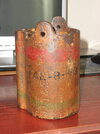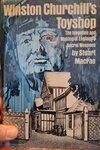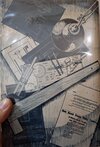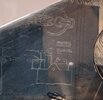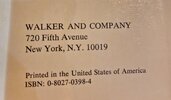I bought a replica Mk II mine from Relics.org and decided it could be improved with paint, markings, a better looking lever out of steel, some grinding on the cartridge pistol, and replaced striker ends with steel ones. The outer shell, detonator pistol, and lever are resin and the "explosive" part and cartridge pistol is wood. I asked them to make the mine removable and short, so a large space under it could be filled with lead to make the thing feel more realistic. Price is reasonable at 70.80 GBP, especially since I was interested to put some sweat equity into it. I just noticed they improved part of the detonator pistol. I am not happy with the way they made mine, not sure if I want to fix it. If I do I'll probably cut it off and get my friend with a 3D printer plus a lathe to make an accurate one with ribs. Right now he is busy making a Type 6 Limpet, AC Delay bursters, and an AC Delay or two for the display I am putting together for a military vehicle show in April.
My Relics one came in looking much like this photo on their website:
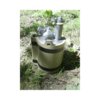
Overly simple cartridge pistol top, no threads at the bottom, which we can see in photos of genuine ones. The lever on mine was flexible resin, same width throughout, and short. Not like the genuine one. Yellowish color, faded-looking. Stripes not the right color.
What I came up with. No handle yet. Top of the detonator pistol (on left) is odd. The current one they advertise above is much better. Not sure if the 80/20 marking for the Amatol filling should be there. I like it - a conversation starter. Some on BOCN say yes and I believe some think only a green stripe is right.
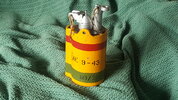
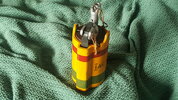
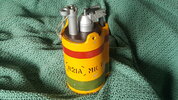
I ground and bent a piece of flat steel to make a better handle, and used a small grinder to carve out the trip plate to look much like the original one. Removing the striker top made this easier, and it is replaced with a steel one. I put some markings on one side of the detonator pistol by heating some 1/8 inch stamps and pressing them into the resin. It will get a broad arrow on the other side. Painted markings are educated guesses and the stripes are crude, like what might have been done by a little Welsh girl after a night drinking with American fliers.
There are some nicks on it but didn't want to make it look 80 years old, or like a new one just out of the crate. Yellow is "School Bus Yellow," the bounding part is "Espresso," and the pistols are a metallic paint that looked the best of what was available. I think these parts were zinc. The lever is painted with Aluma-Hyde brand Parkerizing Gray that many people here use on machine guns.
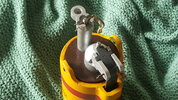
I stamped some unfortunately not-neat markings on the lever. I doubt if I find anyone in California who has ever seen one of these, so it won't be like our vehicle events where we have the "Jeep Police" and "rivet counters" to worry about. I have the mine set proud of the mortar - don't know if that is right but I like it.
The lever has some markings, again, not very good looking. The hole was already on the flat bar I had available. The weights are .38-55 caliber lead bullets I cast many years ago when I was reloading for a vintage Winchester Model 1885 single shot, "low wall" rifle, designed by John Browning for long range target shooting which was very popular in the U.S. in the late 1800s. About as popular as golf is today, believe it or not. As you can see the mine will come out, in case I need some bullets.
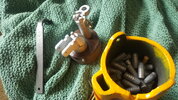
It weighs 6 1/2 pounds which feels good. I believe the genuine ones were 10. Very chunky and over-engineered I think.
A step up, as mentioned, would be 3D printing a new detonator pistol. The cartridge pistol top relics makes can be ground to look good, so anyone wanting to improve one of these should do what I did. I might cut off and save just the top, and have my friend with a lathe put some threads on a new wood or plastic dowel and attach this top to it. The pistol should look like it's mostly but not completely threaded into the mine.
I should be working on my replica SAS jeep and building the table top display cases for the SOE/MD1 sabotage and infantry equipment display planned for April. But this was a fun one for a retired guy. If anyone has any suggestions, please sound off.
John in California

